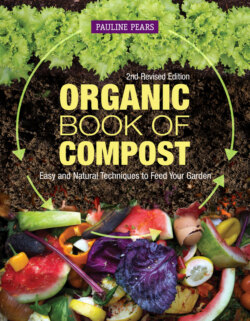Читать книгу Organic Book of Compost - Pauline Pears - Страница 10
На сайте Литреса книга снята с продажи.
ОглавлениеSo you’ve got lots of reasons to get composting, but where on earth do you start? This chapter looks at some of the things you need to consider to help you decide how to begin and what method to use. Where to put a container, what sorts of materials you might want to compost and which methods might be right for your circumstances are all addressed in the following pages.
WHERE TO START
There are a number of considerations to keep in mind when trying to determine which method of composting might be right for your circumstances. Where do you live and what do you want to recycle?
EQUIPMENT
Composting doesn’t need any expensive high-tech equipment; as you will learn in the next chapter, the composting organisms do most of the work for you. The only equipment needed is a container for your compost. This could be a plastic compost bin purchased locally, a sophisticated compost tumbler or just a few old pallets nailed together quite roughly and placed somewhere in your garden.
LOCATION
You will also want to think about where to place your compost container. Generally it should be somewhere accessible that receives some direct sunlight. You also want to make it a convenient distance from your kitchen to encourage you to make frequent trips with your kitchen waste and paper. Look at the section entitled “A home for your compost,” here, for more information and ideas on location. Keep in mind that you do not need a garden to start composting; it is perfectly possible to have a small compost box on a balcony or in a small backyard.
COMPOSTING MATERIALS
The next thing that you need is material to put in your compost container. In the section entitled “What can I compost?,” here, we look what you can recycle and define these materials as either being “greens” or “browns.” Greens are wet, sappy materials that break down quickly and browns are dry, fibrous materials that are slower to decompose. A good compost heap needs a balance of both kinds of materials. Too many greens and your compost heap will be too wet, too many browns and it will be too dry; both situations will result in your compost heap not working to its full capacity.
Another question asked by all those new to composting is “can I compost this item or not?”; again the section entitled “What can I compost?” will answer many of these questions.
Once you get started, you may find that you need more than one compost bin.
Vegetable peelings from the kitchen are good for the compost heap.
CHOOSING THE RIGHT METHOD FOR YOU
If you ask five people for advice on the “right” or “best” way to make compost, you are likely to get five different answers. There are many ways of making compost. The best one for you is the method that suits your lifestyle, the time you want to spend on composting, how quickly you want to produce compost, and, most importantly, what sorts of materials you have available from which to make your compost.
The flow chart here aims to help you make these decisions, starting from the ingredients that you want to compost. It takes you through a series of choices and questions. Following these through, you should end up at a green box with one or more composting methods listed in it. From this you continue to the relevant chapter, which will guide you through each method, in a clear and practical way.
Of course, once you’ve got started you may decide to modify or change your method and/or ingredients, so don’t feel that you have to follow the advice of the flow diagram exactly!
Grass clippings rot down quickly. Too many can overwhelm a compost bin and are best recycled in other ways.
CHOOSING THE RIGHT METHOD FOR YOU
Working through this flow chart will lead you to the right method. The choice starts with the purple boxes – “Mainly food waste” or “Mainly garden waste.” Follow the chart through to a green box where you will find one or two suitable methods of composting or an alternative way of recycling. These are described in detail further on in this book.
